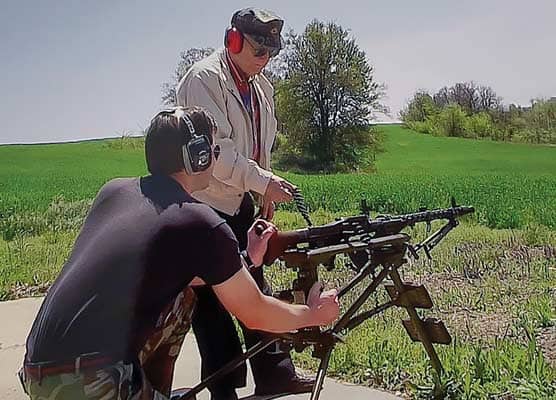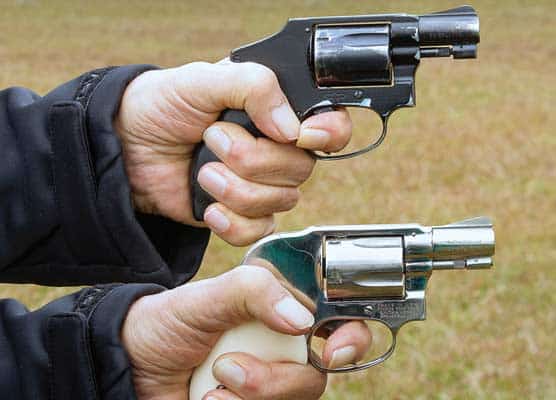| Uncategorized |
3
Recently I’ve been spending time with two .22 rimfire rifles from opposite ends of the spectrum. These guns only have one thing in common other than their caliber—they are both made in America. Nowadays that’s saying a lot.
On the traditional side is Henry Repeating Arms Frontier Lever Action. It’s all wood and metal. On the modern side is Smith & Wesson’s M&P15-22 from their Performance Center. It’s all metal and synthetics—not a speck of wood anywhere.
Now get this: both rifles have the same purpose—recreational shooting (aka plinking), competition, and hunting small game or small varmints. Here’s a reversal, though. The really ugly one by Smith & Wesson has a 10-round magazine so it’s not one of those extremely dangerous ones the news media is so scared of. The Henry Repeating Arms rifle wouldn’t scare a timid grandma by its appearance. Yet it has the highest capacity: 16 rounds of .22 Long Rifle or a truly terrifying 21 rounds of .22 Short.
The Henry lever action is classic all the way. Its magazine is tubular and hung beneath an octagon barrel. To load it, the cartridge follower is removed and .22 cartridges dropped though a port. When that is finished the cartridge follower is reinserted so there is pressure on the rounds.
Likewise the S&W M&P15-22 is AR all the way. Its magazine is a detachable box of 10-round capacity inserted into the receiver from the bottom. To release it a button on the right side of the action is pressed. The .22 rimfire magazine has one nice feature different from centerfire AR magazines.
That is a thumb actuated button on both sides so that the cartridge follower can be depressed manually when feeding rounds in. With centerfire ARs you only push down on rounds to get them in magazines. Rimfire .22 cartridges are just too small for that sort of handling. Smith & Wesson’s website lists 25-round magazines for places where such are legal but noteworthy at this writing is that all their magazines were “out of stock.”
Stock on the Henry lever action .22 is walnut: good old American black walnut. It is of 2-piece design with straight grip and shotgun style butt capped with checkered plastic buttplate. Forearm is secured to the barrel with a band as was common on Winchester and Marlin carbines of the Old West.
You couldn’t have two completely different .22s than the Henry Frontier Lever Action
(top) and the Modern Sporting Rifle looks of the Smith & Wesson M&P15-22.
Buttstock on the Smith & Wesson M&P15-22 is the telescoping collapsible type also seen on carbines—AR type carbines not Western ones. When closed the M&P15-22’s overall length is 32 inches. When extended it is 35-3/4 inches. Length of pull goes from 10 inches to 13-1/2 inches. Of course as per all ARs there is a pistol grip and being from the Performance Center this one’s by Hogue. As for a forearm, there isn’t a smooth place on the M&P15-22s anywhere. It’s all rails; top bottom and both sides. There are enough rails to satisfy a railroad. Modern shooters can hang all sorts of accouterments on those rails from exotic sighting devices to flashlights. Personally I’m going to keep my M&P15-22 clean of such things because I like its 5.4-pound weight. Perhaps someday aging eyesight will force me to scope it but that’s all.
On the subject of sights, the Henry lever gun is again completely traditional. Front sight is a blade with brass bead on a stud dovetailed to the barrel. Rear sight is a buckhorn also dovetailed to the barrel. Elevation adjustment is by a notched slider. Zeroing for windage is accomplished by drifting either front or rear sights in their dovetails. This is just how Old West lever actions were sighted in.
Sights on the Smith & Wesson M&P15-22 are a bit more complicated and a bit more precise in adjustments. First off they are attached to the rail by means of large knurled screws with slots. In other words they can be easily attached by hand tightening so someone can try them in various locations and then mechanically tightened further when properly placed. The front sight is a post and its position can be moved vertically as common with many ARs by pressing something pointed (FMJ bulletnose) on the spring-loaded locking stud and simultaneously pushing clockwise or counter-clockwise as needed. That’s for rough zeroing elevation.
Finer adjustments are done in the rear peep sight, which incidentally has two apertures. There is a small one for more precise shooting and then a larger one for more quickly acquiring the front post. Elevation is moved by a wheel beneath the sight. Turning it clockwise moves point of impact up; counter-clockwise movement lowers point of impact. Also, windage is changed in the rear sight by a knob on the sight’s right side. Turning it clockwise moves point of impact to the right and vise-versa.
Both Henry and Smith & Wesson .22s can be easily scope mounted. The Henry’s receiver is grooved on top for traditional .22 rimfire style scope mounts. Being so light at just over 6 pounds and well balanced, if I ever scope it, my pick will be something likewise light and handy. Of course the M&P15-22 has that top rail meaning that its metallic sights can be easily removed for scope mounting.
As with most everything in comparing these two rifles, the safeties are opposite. On the Henry .22 it is nothing more than the 1/2-cock notch in the hammer. In my experience-based opinion it should never be carried with a round in the chamber. On the M&P15-22 there is the typical AR lever on the left side of the receiver. Moved so it points upward and the rifle is ready to fire. Moved so it points forward and it’s on “SAFE.” There is a bolt hold open device, again typical AR in style. When the last round is fired the bolt locks rearward. When a fresh magazine is inserted pushing a button also on the frame’s left side releases it to slide forward, chambering a round in the process.
Of course their modes of operation are completely different too. (Although I doubt that it actually needs describing.) The Henry’s lever must be cycled up and down for each and every shot whereas the Smith & Wesson is semi-auto. Each pull of the trigger fires a round until the magazine is empty.
Now let’s look at their receivers. The Henry’s is alloy and given a shiny black finish. The Smith & Wesson’s receiver is polymer with black matte finish typical of ARs. Barrels, of course, are steel. The Henry’s is octagon in shape, 20 inches long and given a nice polish and blue. The M&P15-22’s barrel is round and also grooved to reduce weight. It is 18 inches long and also black matte finished.
I was especially interested to see if the internal parts of both rifles were steel or if some sort of pot-metal was used as I’ve seen with lesser quality .22s. A magnet showed that the AR-type rifle’s bolt, trigger and assorted internal parts were steel. Its charging handle is synthetic. The Henry’s lever, trigger, hammer and bolt are steel but I wasn’t about to completely dismantle it to check on smaller internal parts. The important functioning parts inside the receivers of both these rifles are steel and that satisfies me. Triggers on both of these rifles are above criticism. Both break at about 4 pounds with no creep with the Smith & Wesson M&P15-22 having a military style 2-stage trigger.
Loading the Henry Frontier Lever Action is done in the traditional method of
putting cartridges into the magazine through a slot.
One thing both of these .22s have in common is that they are made in America.
The Henry is made in New Jersey. The Marbles Buckhorn rear sight is made in Michigan
One advantage the Henry Frontier Lever Action has over the self loader is that it can
be used with .22 Short, Long and Long Rifle ammunition. Capacity with .22 LR is 16 rounds.
The Smith & Wesson M&P15-22 is only meant for .22 LR. Magazine capacity
is 10 rounds as shown here, although 25-round magazines are available
where legal. They were pretty scarce at presstime.
Duke found the Smith & Wesson’s magazine had an easy-to-depress thumb tab
on the follower, which made loading the tiny rounds easy.
The Smith & Wesson M&P .22 is also made in America. Note the bolt
release in the same spot as on the big brother AR-15.
Smith & Wesson’s M&P15-22 has a peep rear sight adjustable for both windage and
elevation with two apertures. It is rail mounted and can be dismounted if the
shooter decides to mount a scope instead. The Smith & Wesson M&P15-22’s front sight
Is also rail mounted. It is adjustable for elevation for rough zeroing.
Shooting was done only at 25 yards because it was springtime in Montana and the winds were strong. For ammunition I had on hand Federal high speed hollowpoints, CCI Mini-Mags, and some Lapua Midas match-grade standard velocity. Getting the two rifles zeroed at 25 yards was no problem. I thought perhaps some banging on the Henry’s dovetailed sights might be necessary to zero windage but it wasn’t. That means not only were the sights centered on the barrel but it was also bored straight.
Groups were acceptable with the run of the mill-type .22s by Federal and CCI, as one would use for normal plinking or ground squirrel shooting. But the truth of the quality in those barrels came out when firing that Lapua match ammo. Despite winds and metallic sights both rifles grouped well under 1 inch at 25 yards. That doesn’t sound impressive but think about how they could do in calm weather and with good scopes.
Furthermore, there has been nary a bobble with either rifle. The Smith & Wesson M&P15-22 has never failed to feed or function and the Henry’s lever is so smooth it feels like it’s moving on roller bearings. So when all was said and done, I had to admit that these two rifles had one more thing in common besides both being .22s and both being American made. They are both fine little rifles for their intended purpose.
By Mike “Duke” Venturino
Photos By Yvonne Venturino
FRONTIER LEVER ACTION H001T
Maker: Henry Repeating Arms
59 East 1st St.
Bayonne, NJ 07002
(201) 858-4400
www.gunsmagazine.com/henry-rifles
Action: Lever-action repeater, Caliber: .22 Short, Long, and Long Rifle, (tested), .17 HMR, .22 WMR, Capacity: 21 (.22 Short), 16 (.22 LR), Length: 38.5″, Barrel Length: 20″, Weight: 6.25 pounds, Stock: American walnut, Sights: Marbles semi-buckhorn rear, brass bead front, Finish: Blued steel and oil-finish wood, Price: $430 (Magnum models higher)
M&P15-22
Maker: S&W
2100 Roosevelt Ave.
Springfield, MA 01104
(800) 331-0852
www.gunsmagazine.com/smith-wesson
Action: Blowback semi-auto, Caliber: .22 LR, Capacity: 10 or 25, Sights: Adjustable dual aperture rear, adjustable A2 post front, Trigger: 2-stage match, Grip: Hogue Overmolded, Overall Length: 32″ (collapsed), 35.75″ (extended), Stock: 6-position Vltor Stock, Weight: 5.4 pounds, Barrel Length: 18″, Barrel Twist: 1:15″, Barrel: Carbon steel, matte black, Lower Material: Polymer, matte black, Price: $769
Order Your Printed Copy Of The GUNS Magazine September 2013 Today!
Download A PDF Of The GUNS Magazine September 2013 Issue Now!


